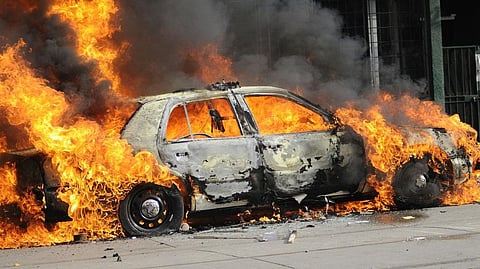
- Home
- न्यूजग्राम
- NewsGram USA
- India
- World
- Politics
- Entertainment
- Culture
- Lifestyle
- Economy
- Sports
- Sp. Coverage
- Misc.
- NewsGram Exclusive
- Jobs / Internships

New Delhi: Terrorists used similar explosives in the bombings at Bihar's Gandhi Maidan, an express train in Chennai, outside a college in Uttarakhand and near a restaurant in Karnataka between 2013-2014, NIA sources said.
Sleuths of National Investigation Agency (NIA) figured this out when they managed to arrest Alam Jeb Afridi alias Javed Rafeeq, the prime accused in the December 28, 2014, Bengaluru Church Street blast. They were assisted in the effort by the Telangana Anti-terrorist Squad (ATS).
An official of the central counter-terrorism agency, which is probing all the terrorist cases since its establishment on December 31, 2008, said that the outfits behind these four attacks used Ammonium Nitrate, Sulphur and Potassium Chlorate to prepare Improvised Explosive Devices (IEDs).
"The mixture used in preparing the IEDs was then packed in iron pipes," the official, on condition of anonymity told News agency.
A series of bombings rocked Gandhi Maidan on October 27, 2013, killing six and injuring over 80 persons during a Bharatiya Janata Party (BJP) rally attended by Narendra Modi, then the party prime ministerial candidate for the April-May 2014 Lok Sabha elections. The explosions had preceded Modi's arrival.
Six months later, two bombs went off in two coaches of the Bangalore-Guwahati Express at Chennai Central station on May 1, 2014, in which a woman was killed and 14 others were injured.
A 10-year-old boy was killed on December 6 the same when an explosion took place metres away from a college in Roorkee in Uttarakhand where Vishwa Hindu Parishad (VHP) was holding an event to mark the 22nd anniversary of the Babri mosque demolition.
Twenty-one days after this, a bomb exploded outside the Coconut Grove Bar and Restaurant at Bengaluru Church Street on December 28, 2014, which claimed life of a woman and injured many others.
The NIA official said that the agency was yet to link the role of the same module in all four bombings. He said that Rafeeq's interrogation has confirmed the role of the Student Islamic Movement of India (SIMI) outfit in the Bengaluru blast.
Rafeeq had wanted to plant bomb inside the restaurant but was deterred by the presence of staff and, therefore, planted it outside near a wall, the official said.
Rafeeq, who is a SIMI member and was close to several of its top leaders, was also absconding in another case of organising a terrorist camp for the outfit at Waghamon in Kerala. He was declared an absconder with a Rs.3 lakh bounty on his head five years now. He was close to several top SIMI leaders.
The 30-year-old resident of Ahmedabad, who is now in NIA custody, informed his interrogators that he had been residing in Bengaluru for more than three years in the garb of an air-conditioner mechanic.
NIA officials also claimed that Rafeeq's target was an Israeli delegation that was purported to visit Coconut Grove restaurant that day. Rafeeq was the same suspect who stabbed a Telangana ATS constable, Srinivasa, the official said.
The Telangana ATS and NIA had picked him up in connection with the Ahmedabad 2008 blasts but he also confessed his involvement in the Church Street blast case, the NIA official said.
NIA sleuths are also not commenting on whether Rafeeq acted alone or if there was a larger group behind the conspiracy. NIA sleuths said that Rafeeq also carried out the attack on the Israeli visa centre in Ulsoor in Bengaluru in November 2015.
In a preliminary examination, he had disclosed that his handler had taught him the technique of making the bomb for which he procured the material locally. "During the search of his residence is Bangalore, the investigators recovered a lot of anti-Semitic hate literature," the NIA official said. (IANS) (picture courtesy: fastcoexist.com)
